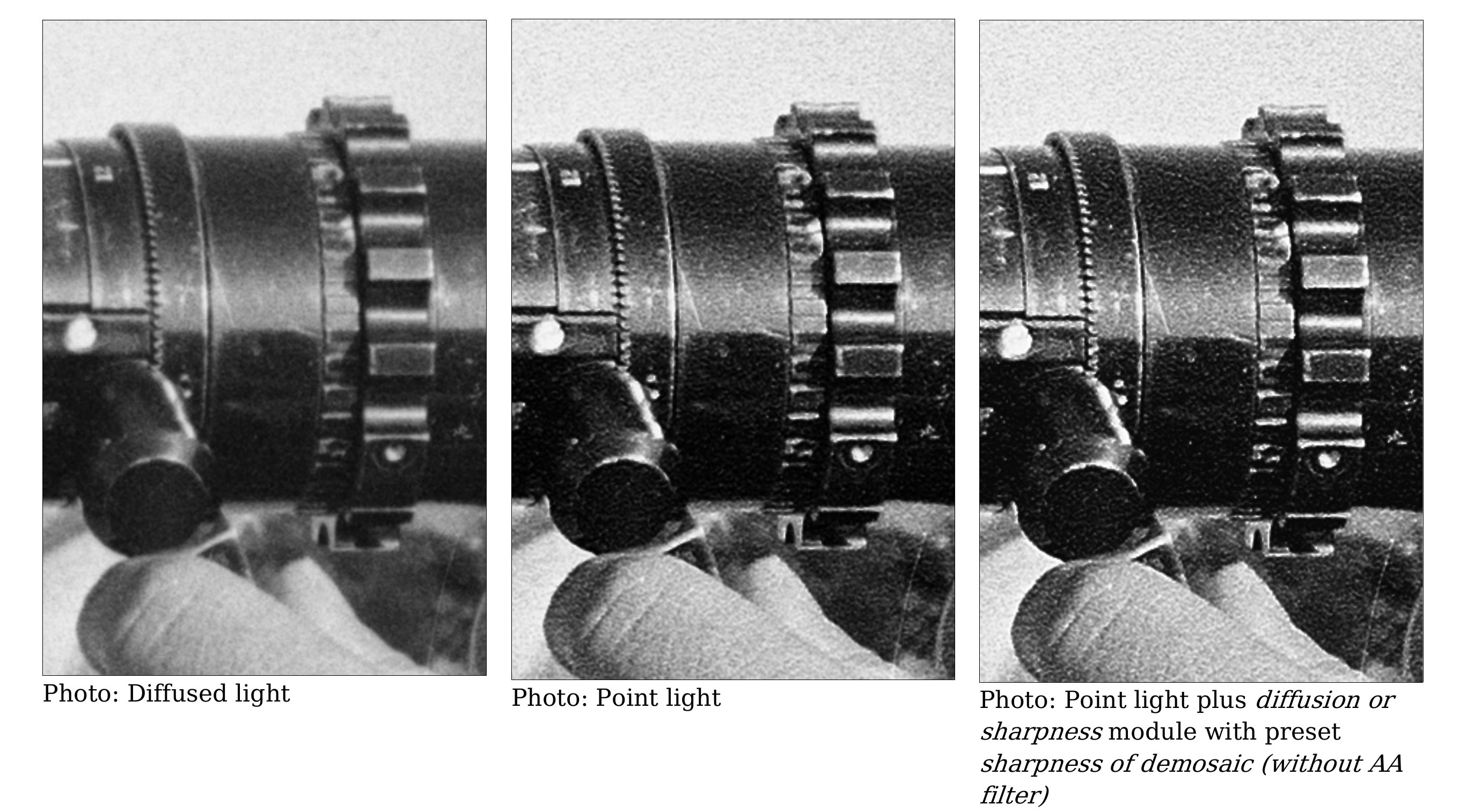Alain Oguse learned photographic printing with Claudine and Jean-Pierre Sudre in the late 1960’s, and spent his early career in commercial photography. After retiring, he started to investigate how to bring back the photographic (silver halide) grain in digital scans of film negatives, finding the same sharpness and quality he had with near-point light enlargers in the 1970’s.
The point light printing technique uses a very tiny source of light that gives a very precise and detailed reproduction of B&W film negatives, as opposed to diffuse lighting. It is very demanding, as its unforgiving sharpness and contrast do not hide scratches and dust on the film surface. Prints done this way would often need manual (painted) corrections on paper, inducing more work and more costs. By the end of the 1970’s, it was usually replaced by diffuse light… better at hiding manipulation mistakes and at maximizing print labs profits.
But cleaning up negatives is no issue once they are digitized, and on this topic, Alain and I share the same values : digital imaging should augment the possibilities offered to photographers, building on top of the analog legacy, instead of settling down for what is easy and fast while trying to re-invent photography as if it was born digital.
As an early Ansel user, Alain contacted me to get help on tuning the Diffuse or sharpen module to dial up or down the photographic grain in a way that closely reproduces the impact of the enlarger light source quality (point or diffused) on the final print, starting with a DSLR scan. After all, light diffusion is what happens here.1
But he also built a complete apparatus to achieve the initial film scan and was kind enough to document and illustrate all of his process, from preparation to post-processing, translate it into English and allow me to publish it here. You get for free the very finest of what open-source has to give you:
- 50 years of experience from Alain,
- real-life examples and results,
- optical explanations of what’s going on,
- complete schematics of the scanning apparatus in point light setting,
- physically-accurate modules from Ansel/Darktable pixel pipeline, and presets for demosaicing, input color profile and diffuse or sharpen modules to dial the grain up or down at post-processing,
- thoughts on the work and responsibility of a print lab technician, regarding heritage conservancy and exhibition quality.
Please note that Alain is a French speaker and this book was mostly translated using machine translation. If you understand French enough, you might want to read the original version.
Summary of Ansel settings
These settings assume you scan B&W negatives using quasi-monochromatic green light with a digital camera.
- Download the color profile IdentityRGB-elle-V2-g10.icc and put it into both folders:
- for Linux/Mac:
~./config/ansel/color/in~./config/ansel/color/out
- for Windows:
./AppData/Local/ansel/Color/In./AppData/Local/ansel/Color/Out
- for Linux/Mac:
- Open your film scan into Ansel,
- Set the demosaicing module to use VNG42 mode,
- Set the input color profile module to use
IdentityRGB-elle-V2-g10.iccas input profile and working profile, - Set color calibration module :
- in the CAT tab, set the adaptation to none (bypass),
- in the B&W tab, set the green channel to 1,0 and the blue/red channels to 0,0.
- See the book for settings of diffuse or sharpen.
These settings allow to avoid any possible cross-talk between channels, either arising from demosaicing (that can use collaborative methods between channels, for methods other than VNG4) or from color spaces conversions (in which cross-talk is built-in by design into the matrix calculus). This way, any possible chromatic aberration linked to optical refraction, which varies depending on light wavelength, is removed and, if you scan under quasi-monochromatic green light, the sharpness of your scan will be maximum because only the green photosites of the camera sensor will be used. In practice, this is equivalent to completely removing trichromy from the graphic pipeline.
This, of course, will not work for color negatives and slides, which will require a broad-spectrum white light and a trichromatic color management.
Though it should be mentionned that diffuse or sharpen uses thermal diffusion models (Fourier heat equation ) in wavelets space . This equation can also model particle diffusion, and its fundamental solution can be identified as a convolution with a Gaussian function (aka producing here a very computationnaly-expensive Gaussian blur with the right settings). But since we apply it in wavelets space and we don’t do it at the photon level, I cannot in good faith claim physical accuracy here, with regard to light diffusion. It’s rather physically-inspired generalized diffusion. ↩︎
CHANG, Edward, CHEUNG, Shiufun, et PAN, Davis Y. Color filter array recovery using a threshold-based variable number of gradients. In : Sensors, Cameras, and Applications for Digital Photography. SPIE, 1999. p. 36-43. https://doi.org/10.1117/12.342861 ↩︎
